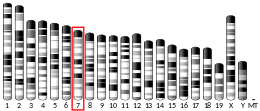C16orf58
Chromosome 16 open reading frame 58, or C16orf58, also known as FLJ13638 is a protein which in humans is encoded by the C16orf58 gene.[5] The gene itself is 18892 bp long, with mRNA of 2760 bp, and a protein sequence of 468 amino acids. There is a conserved domain of unknown, DUF647. No function has been determined for this gene yet, but it is predicted that it resides in the endoplasmic reticulum in the cytoplasm.[6]
| RUSF1 | |||||||||||||||||||||||||
|---|---|---|---|---|---|---|---|---|---|---|---|---|---|---|---|---|---|---|---|---|---|---|---|---|---|
| Identifiers | |||||||||||||||||||||||||
| Aliases | RUSF1, RUS, chromosome 16 open reading frame 58, C16orf58, RUS family member 1 | ||||||||||||||||||||||||
| External IDs | MGI: 2384572 HomoloGene: 11232 GeneCards: RUSF1 | ||||||||||||||||||||||||
| |||||||||||||||||||||||||
| |||||||||||||||||||||||||
| Orthologs | |||||||||||||||||||||||||
| Species | Human | Mouse | |||||||||||||||||||||||
| Entrez | |||||||||||||||||||||||||
| Ensembl | |||||||||||||||||||||||||
| UniProt | |||||||||||||||||||||||||
| RefSeq (mRNA) | |||||||||||||||||||||||||
| RefSeq (protein) | |||||||||||||||||||||||||
| Location (UCSC) | Chr 16: 31.49 – 31.51 Mb | Chr 7: 128.27 – 128.3 Mb | |||||||||||||||||||||||
| PubMed search | [3] | [4] | |||||||||||||||||||||||
| Wikidata | |||||||||||||||||||||||||
| |||||||||||||||||||||||||
Species distribution
C16orf58 has very interesting conservation in that it has orthologs back through plants and fungi. However, it has not been found in reptiles, birds, or amphibians. The below table shows some, but not all, orthologs which were found using BLAST.[7]
| Species | Organism Common Name | NCBI Accession | Sequence Identity | E-value | Length (AAs) | Gene Common Name |
| Homo sapiens | Human | NP_073581 | 100% | 0.0 | 468 | C16orf58 |
| Equus Caballus | Horse | XP_001495510 | 85% | 0.0 | 468 | PREDICTED: similar to UPF0420 protein C16orf58 |
| Canis familiaris | Dog | XP_547054 | 85% | 0.0 | 485 | similar to CG10338-PA |
| Mus musculus | Mouse | Q91W34 | 81% | 0.0 | 466 | cDNA sequence BC017158 |
| Monodelphis domestica | Opossum | XP_001370394 | 65% | 3e−160 | 466 | PREDICTED: hypothetical protein |
| Danio rario | Zebrafish | NP_001103923 | 53% | 4e−112 | 432 | hypothetical protein LOC555936 |
| Drosophila melanogaster | Fly | NP_609897 | 40% | 3e−69 | 395 | CG10338 |
| Arabidopsis thaliana | Thale Cress | AAF81284 | 37% | 2e−68 | 403 | Contains similarity to CG10338 gene product from Drosophila melanogaster |
| Gallus gallus | Chicken | NP_989823 | 25% | 0.36 | 1434 | protein tyrosine phosphatase, receptor type, U |
| Xenopus tropicalis | Frog | AAI22058 | 31% | 3.4 | 268 | Stk19 protein |
| Saccharomyces cerevisiae | Yeast | EDZ73379 | 25% | 0.21 | 1578 | YDL140Cp-like protein |
| Caenorhabditis elegans | Nematode | NP_502300 | 19% | 3.0 | 414 | hypothetical protein M18.6 |
Protein Interactions
Though the function is still unknown, C16orf58 has been shown to interact with three different proteins:
- MVD[8] MVD stands for disphosphomevalonate decarboxylase which is an enzyme which functions in cholesterol biosynthesis.[9]
- BSCL2[10] BSCL2 is the Bernardinelli-Seip congenital lipodystrophy 2, or seipin.[11] It located in the endoplasmic reticulum and is thought to be important in the lipid droplet morphology.
- TSC22D4[10] The third interacting protein is TSC22D4, TSC22 domain family member 4, and functions as a leucine zipper translational regulation.[12]
Structure
Although there are several sites that will give predictions on protein structure, C16orf58 does not have a known structure yet. That being said there is at least one transmembrane domain, if not more. Within the protein structure there are several extended areas with uncharged amino acids, these could be possible transmembrane domains, or hydrophobic cores.[6] The below shows the charge of each of the amino acids in the protein sequence, + for positive, - for negative and 0 for uncharged. Note the large segments of uncharged amino acids appear bolded. These stretches of uncharged amino acids are conserved back through distant orthologs.
1 00—000-00 000-00000- 0+00+000-0 0000-0000+ 00000+0000 +0-0+-00-0
61 0000000000 0000000000 000-0000-0 000000-000 0000000000 0000000000
121 0000+00000 0000000+-0 00000+0000 00+00+0-00 0+00+000-0 00-00000-0
181 0000000000 000000000+ 0000000000 +00000000+ +0000-000+ -000-00000
241 0000000000 0000000000 0000000000 000000+00+ 0000-000-0 +0+000+000
301 0+0-00-000 00+0-00000 0000000000 0000+00000 0-00000-00 0-000000-0
361 0000000000 0+000+000+ 0000000000 000-00000- 0—0+0+0+0 00++-00000
421 +-00-00-00 00+00+000- 000+0-+000 -00-0+0000 000-++00
References
- GRCh38: Ensembl release 89: ENSG00000140688 - Ensembl, May 2017
- GRCm38: Ensembl release 89: ENSMUSG00000030780 - Ensembl, May 2017
- "Human PubMed Reference:". National Center for Biotechnology Information, U.S. National Library of Medicine.
- "Mouse PubMed Reference:". National Center for Biotechnology Information, U.S. National Library of Medicine.
- "Entrez Gene: C16orf58". Retrieved 6 May 2009.
- "SDSC Biology Workbench". San Diego Supercomputer Center. Retrieved 2009-05-07.
- "BLAST: Basic Local Alignment Search Tool". National Center for Biotechnology Information, United States National Institutes of Health. Retrieved 2009-05-07.
- "STRING: functional protein association networks". EMBL.de. Retrieved 2009-05-07.
- "Entrez Gene: MVD mevalonate (diphospho) decarboxylase". Retrieved 6 May 2009.
- "mint database". Archived from the original on 2006-05-06. Retrieved 2009-05-07.
- "Entrez Gene: BSCL2 Bernardinelli-Seip congenital lipodystrophy 2 (seipin)". Retrieved 6 May 2009.
- "Entrez Gene: TSC22D4 TSC22 domain family, member 4". Retrieved 6 May 2009.
External links
- Human C16orf58 genome location and C16orf58 gene details page in the UCSC Genome Browser.



